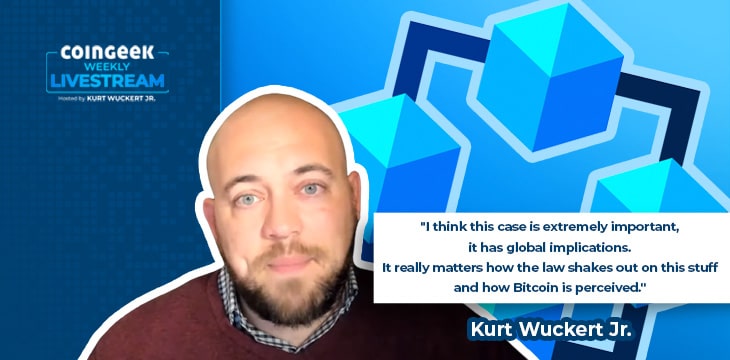|
Getting your Trinity Audio player ready...
|
Welcome to CoinGeek’s Kurt Wuckert Jr.’s coverage of Day 3 of the Granath v Wright trial. Wuckert is giving daily recaps on what’s happening inside the court, and this livestream covers today’s proceedings in which both Magnus Granath and Dr. Craig Wright took the stand. Enjoy it via the video link or read a written summary below.
Magnus Granath steps into the light
Granath took the stand first on Wednesday’s trial. After introducing himself, he got into the culture of Bitcoin, coming from the BTC side. He mentioned Nick Szabo, Hal Finney, and various BTC icons.
The Norwegian explained that he learned about Bitcoin from Reddit community r/Bitcoin and spent time on the BitcoinTalk forum. He explained that he feels toxic maximalism is important and that the uncompromising attitude he has displayed is a way to bring people into the revolution.
Granath recalled how Dr. Wright showed up on the Bitcoin scene and addressed Nick Szabo disrespectfully (in his perception) during their debate about Bitcoin’s Turing Completeness. Wuckert detected reverence for Szabo in Granath and finds it strange that he interpreted it that way. He recalls how he heard the same interaction and was fascinated by what Dr. Wright had to say.
Author’s note: This reverence for leaders is a common trait in many BTC advocates. They will criticize other projects for having visible leaders (e.g., Ethereum’s Vitalik Buterin), but at the same time believe their own community leaders without question and speak of Satoshi Nakamoto with near-religious zeal. Wuckert rightly calls this an appeal to authority – a well-known logical fallacy.
Wuckert explains how Granath was all over the place in the court. He talked about how Dr. Wright was wrong at times and spoke about how Charlie Lee had moved a coin to prove he invented Litecoin. At other times, he said he didn’t really understand what Turing Completeness means. He even made reference to “carnivore culture” in Bitcoin. Wuckert likened him to an unruly kid being watched with a sense of mild puzzlement by the judge.
Overall, Wuckert summarizes Granath’s time on the stand as an attempt to justify why it is OK to be a toxic bully.
“He came across as flippant,” he said.
Dr. Craig Wright takes the stand
Wuckert begins by saying that he learned a couple of new things today, including seeing new pieces of evidence such as handwritten white paper drafts and a note from Alan Grainger at BDO speaking of an electronic cash system Dr. Wright was working on before Bitcoin was released.
“Halvor Manshaus [Dr. Wright’s attorney] cuts right to the chase. He’s very good at setting up narratives,” Wuckert said.
He asked Dr. Wright immediately what happened and how it made him feel. He told the court about threats against himself and his family, including racist abuse and threats to rape his wife and daughter.
Manshaus asked Dr. Wright how it made him feel to be called a pathetic loser. Wuckert notes that Granath was visibly enjoying the recollection of his mean tweets and the toxicity he whipped up.
At this point, Manshaus begins to delve into Dr. Wright’s past. He recalled how he got his first computer in 1979, set up serious infrastructure for big corporations, and worked for the Australian government. He explained his connection to Japanese culture and how his grandfather was embedded with a unit there in World War II, hence the name Satoshi Nakamoto.
Delving deeper, Dr. Wright explained how he worked with law enforcement to put some truly evil human beings behind bars and save lives. Wuckert rightly points out that this completely contrasts with Granath’s sneering, mean character.
Eventually, they got into a long-form blog post by Jameson Lopp on why Dr. Wright is not Satoshi Nakamoto. In it, Lopp explains how Bitcoin should work and how Satoshi could prove himself. This was much like a quiz, Wuckert said, noting how Dr. Wright enjoyed this part of it.
Wuckert said that if Dr. Wright had a weak moment today, it was during the cross-examination by Granath’s lawyers. They asked him how he was able to sign for Gavin Andresen and Jon Matonis but is unable to do so now. This led to Dr. Wright explaining the difference between private keys and key slices, which came across as somewhat evasive and unclear.
This was unacceptable to Granath’s attorneys, Wuckert says, so they pressed him on the matter. Dr. Wright responded that, technically, the keys could be regenerated and coins could be moved, but it would be nearly impossible. He went into detail on how he had been pressured into signing for Andresen and Matonis and that he never wanted this to happen again.
Questions and answers
Q. Could the McCormack judge be waiting for this trial to conclude before making his final relief judgments?
Wuckert obviously can’t say for sure, but he agrees that it’s a reasonable assumption.
Q. How was Craig’s demeanor? Was he nervous?
Wuckert describes it as “genuine” and feels it was his best court performance. He emoted both positively and negatively. He came across as a kind and genuine person who loves Bitcoin.
Q. Did the judge understand the difference between proof of possession and proof of identity?
Wuckert says she absolutely did understand it. She also understood the implications of it and even summarized it back to Dr. Wright.
Q. What was the overall consensus of those in the courtroom after today?
Wuckert says he didn’t talk to the small blockers today. However, those he did talk to were astounded that Granath thought it was OK to behave the way he did. There was also a lot of intrigue about Dr. Wright’s story and evidence.
Q. How many witnesses will there be for HODLonaut and Craig?
Wuckert has heard Granath has three and Dr. Wright has five. However, he has heard that Dr. Wright may have ten. He wants as many as possible as this is in keeping with his philosophy on how identity is attested.
Watch: The BSV Global Blockchain Convention presentation, BSV Blockchain: A World of Good

 01-07-2026
01-07-2026 




